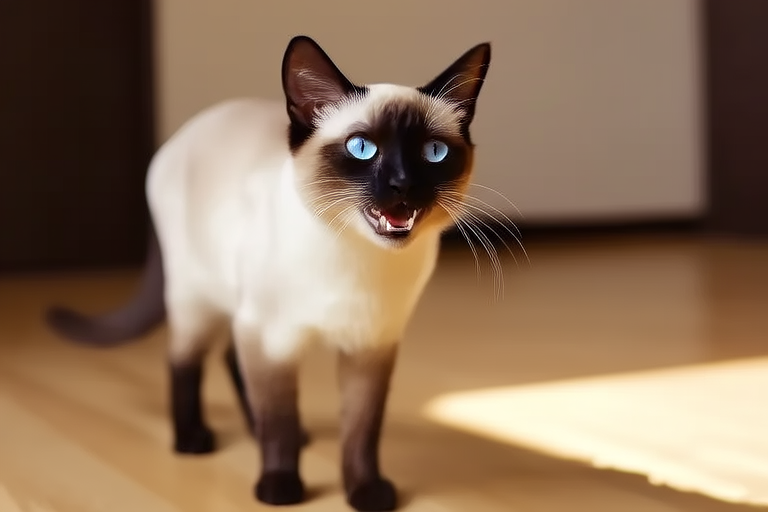The Unique Vocal Characteristics of Siamese Cats
Siamese cats are renowned for their striking blue almond-shaped eyes, sleek bodies, and vibrant coat colors. However, what truly sets them apart is their remarkable ability to communicate through an array of vocalizations. This article explores the origins of the breed, their distinctive meowing patterns, and the profound impact of their vocal characteristics on human affection.
Origins of the Siamese Breed
The Siamese breed originated in Thailand, formerly known as Siam, where it was considered a sacred animal and kept by royalty. These cats were believed to bring good fortune and were often depicted in ancient Thai manuscripts. The first Siamese cats were introduced to the Western world in the late 19th century, when they were gifted to British diplomats stationed in Bangkok. Their exotic appearance and unique vocalizations quickly captured the hearts of cat enthusiasts.
Distinctive Meowing Patterns
Siamese cats are often referred to as the ‘vocalists’ of the feline world due to their distinct and varied vocal repertoire. Unlike most cats, who typically meow only to communicate with humans, Siamese cats meow frequently and loudly, even when communicating with each other. Their meows can range from soft coos to loud, demanding yowls, depending on their mood or the situation.
Scientifically, cat communication primarily involves body language, scent marking, and vocalizations. Cats use different types of sounds to convey various messages. For instance, purring usually indicates contentment, while hissing or growling signifies aggression or fear. Siamese cats have a more extensive vocabulary, utilizing their vocal abilities to express a wider range of emotions and needs. They may chirp when they see birds or other small animals, trill when greeting their owners, or let out a piercing scream when they feel neglected or hungry.
Comparisons with Other Breeds
While all cats can be vocal at times, Siamese cats stand out for their persistent and expressive vocalizations. In comparison to quieter breeds like the Maine Coon or the Ragdoll, Siamese cats are much more talkative. Their vocal tendencies make them ideal companions for people who enjoy interactive conversations with their pets. However, this trait can also be challenging for those who prefer a more serene environment.
Personal Anecdotes
Many owners of Siamese cats have shared stories of how their pets’ vocalizations have enhanced their lives. One owner recounted how her Siamese cat, named Luna, would wake her up every morning by standing on her chest and meowing until she got out of bed. While initially annoying, this ritual soon became a cherished part of their daily routine. Another owner mentioned how his Siamese cat, Max, would follow him around the house, meowing and chirping as if having a conversation. These anecdotes illustrate the strong emotional bonds formed between Siamese cats and their owners through their vocal expressions.
Emotional Bond and Popularity
The vocal prowess of Siamese cats contributes significantly to the emotional bond they form with their owners. Their constant communication creates a sense of connection and companionship that many find irresistible. This deep bond has made Siamese cats one of the most popular breeds worldwide.
Owners often report feeling a greater sense of responsibility towards their Siamese cats due to the intensity of their vocalizations. They understand that their pets are trying to communicate specific needs or emotions, which fosters a deeper understanding and empathy. This unique relationship is a key factor in the breed’s enduring appeal.
Tips for Potential Owners
If you’re considering adopting a Siamese cat, here are some tips for understanding and responding to their vocal cues:
- Pay Attention to Tone and Pitch: Siamese cats use different tones and pitches to express varying emotions. A high-pitched meow might indicate excitement or curiosity, while a lower, more urgent tone could signal distress or hunger.
- Establish Routines: Consistent feeding, play, and grooming schedules can help reduce unwanted vocalizations. Siamese cats thrive on routine and predictability, so establishing a regular schedule can satisfy their need for attention and interaction.
- Respond Positively: When your Siamese cat meows, try to respond positively by petting, playing, or providing treats. This reinforces the behavior and encourages further communication.
- Ignore Negative Behavior: If your Siamese cat meows excessively for attention, try ignoring the behavior instead of giving in. Over time, they will learn that certain vocalizations won’t result in desired outcomes.
- Consult a Veterinarian: Persistent or unusual vocalizations can sometimes indicate health issues. If you notice changes in your Siamese cat’s vocal habits, consult a veterinarian to rule out any underlying medical conditions.
Conclusion
The unique vocal characteristics of Siamese cats have captivated both cat enthusiasts and casual observers alike. Their origins in Thailand, combined with their distinctive meowing patterns, have made them a beloved breed. Scientific insights into cat communication reveal that Siamese cats possess a more extensive vocabulary than many other breeds, enhancing their ability to form strong emotional bonds with their owners. Personal anecdotes and comparisons with other breeds further highlight their communicative prowess. By understanding and responding to their vocal cues, owners can strengthen their relationships with these fascinating creatures and ensure a fulfilling life together.
